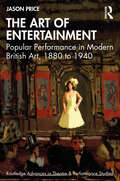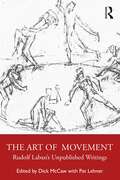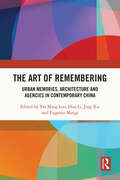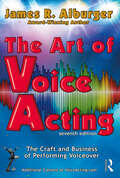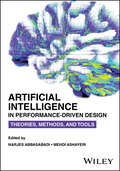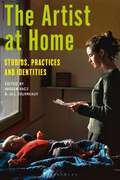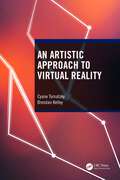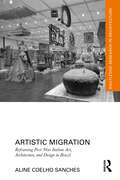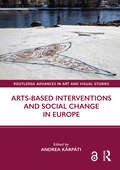- Table View
- List View
The Art of Entertainment: Popular Performance in Modern British Art, 1880 to 1940 (ISSN)
by Jason PriceIn this book, theatre historian Jason Price looks at the relationships and exchanges that took place between high and low cultural forms in Britain from 1880 to 1940, focusing on the ways in which figures from popular entertainments, such as music hall serio-comics, clowns, and circus acrobats, came to feature in modern works of art.Readers with an interest in art, theatre, and the history of modern Britain will find Price’s approach, which sees major works of art used to illuminate the histories of once-famous entertainers and the wider social, political, and cultural landscape of this period, accessible and engaging. The book will bring to life for readers some of the most vivid works of modern British art and reveal how individuals historically overlooked due to their gender, sexuality, or race played a significant role in the shaping of British culture during this period of monumental social change.
The Art of Entertainment: Popular Performance in Modern British Art, 1880 to 1940 (ISSN)
by Jason PriceIn this book, theatre historian Jason Price looks at the relationships and exchanges that took place between high and low cultural forms in Britain from 1880 to 1940, focusing on the ways in which figures from popular entertainments, such as music hall serio-comics, clowns, and circus acrobats, came to feature in modern works of art.Readers with an interest in art, theatre, and the history of modern Britain will find Price’s approach, which sees major works of art used to illuminate the histories of once-famous entertainers and the wider social, political, and cultural landscape of this period, accessible and engaging. The book will bring to life for readers some of the most vivid works of modern British art and reveal how individuals historically overlooked due to their gender, sexuality, or race played a significant role in the shaping of British culture during this period of monumental social change.
The Art of Mary Linwood: Embroidery, Installation, and Entrepreneurship in Britain, 1787-1845 (Material Culture of Art and Design)
by Dr. Heidi A. StrobelThe Art of Mary Linwood is the first book on Leicester textile artist Mary Linwood (1755-1845) and catalogue of her work. When British textile artist and gallery owner Mary Linwood died in 1845 just shy of 90 years old, her estate was worth the equivalent of £5,199,822 in today's currency. As someone who made, but did not sell, embroidered replicas of famous artworks after artists such as Gainsborough, Reynolds, Stubbs, and Morland, how did she accumulate so much money? A pioneering woman in the male-dominated art world of late Georgian Britain, Linwood established her own London gallery in 1798 that featured copies of well-known paintings by these popular artists. Featuring props and specially designed rooms for her replicas, she ensured that her visitors had an entertaining, educational, and kinetic tour, similar to what Madame Tussaud would do one generation later. The gallery's focus on picturesque painters provided her London visitors with an idyllic imaginary journey through the countryside. Its emphasis on quintessentially British artists provided a unifying focus for a country that had recently emerged from the threat of Napoleonic invasion.This book brings to the fore Linwood's gallery guides and previously unpublished letters to her contemporaries, such as Birmingham inventor Matthew Boulton and Queen Charlotte. It also includes the first and only catalogue of Linwood's extant and destroyed works. By examining Linwood's replicas and their accompanying objects through the lens of material culture, the book provides a much-needed contribution to the scholarship on women and cultural agency in the early 19th century.
The Art of Movement: Rudolf Laban’s Unpublished Writings
The Art of Movement: Rudolf Laban’s Unpublished Writings offers new perspectives on the thinking and practice of Rudolf Laban – one of the pioneers of modern European dance and movement analysis. A wealth of Laban’s previously untranslated writings broadens our understanding of his work through new perspectives on his thinking and practice. Alongside these key primary sources, interviews with Laban’s family and colleagues and editorial commentaries shed new light on the significance of his life and career. Laban’s own texts also offer further elaboration of the key themes of his work – eukinetics, choreutics, lay dance, pedagogy and dance notation. This essential companion to The Laban Sourcebook is an ideal resource for any students or scholars of modern dance, dance studies, dance history and movement analysis looking for a deeper understanding of this seminal figure in their field.
The Art of Movement: Rudolf Laban’s Unpublished Writings
by Dick McCawThe Art of Movement: Rudolf Laban’s Unpublished Writings offers new perspectives on the thinking and practice of Rudolf Laban – one of the pioneers of modern European dance and movement analysis. A wealth of Laban’s previously untranslated writings broadens our understanding of his work through new perspectives on his thinking and practice. Alongside these key primary sources, interviews with Laban’s family and colleagues and editorial commentaries shed new light on the significance of his life and career. Laban’s own texts also offer further elaboration of the key themes of his work – eukinetics, choreutics, lay dance, pedagogy and dance notation. This essential companion to The Laban Sourcebook is an ideal resource for any students or scholars of modern dance, dance studies, dance history and movement analysis looking for a deeper understanding of this seminal figure in their field.
The Art of Remembering: Urban Memories, Architecture and Agencies in Contemporary China
by Hua Li Jing Xie Yat Ming Loo Eugenio MangiFocusing on the non-Western context and case studies, this book explores theories of interdisciplinary architectural thinking and the construction of urban memory in Chinese cities, with an emphasis on contemporary architecture and the diversity of agencies.China has undergone one of the fastest urbanisation and urban renewal processes in human history, but discussions of urban memory in China have tended to be practice-oriented and lack theoretical reflection. This book brings together interdisciplinary architectural scholarship to interrogate the production of urban memory and examine experiences in China. The 14 chapters explore different processes, projects, materials, architecture and urban spaces in different Chinese cities by analysing cityscapes such as temples, bridges, conservation projects, architectural design, historical architecture, memorial hall, market street, city images, custom bike, food market and so on. The book deals with different agencies and methods, tangible and intangible, in the construction of memories aimed at promoting hybridised multiple identities, and explores the interplay of different versions of memory, i.e. state, public, regional, local, individual and collective memory.This book will be essential reading for scholars and students of architecture and urbanism, cultural studies and China studies, as well as architects, urban planners and historians interested in these fields.
The Art of Remembering: Urban Memories, Architecture and Agencies in Contemporary China
by Hua Li Jing Xie Yat Ming Loo Eugenio MangiFocusing on the non-Western context and case studies, this book explores theories of interdisciplinary architectural thinking and the construction of urban memory in Chinese cities, with an emphasis on contemporary architecture and the diversity of agencies.China has undergone one of the fastest urbanisation and urban renewal processes in human history, but discussions of urban memory in China have tended to be practice-oriented and lack theoretical reflection. This book brings together interdisciplinary architectural scholarship to interrogate the production of urban memory and examine experiences in China. The 14 chapters explore different processes, projects, materials, architecture and urban spaces in different Chinese cities by analysing cityscapes such as temples, bridges, conservation projects, architectural design, historical architecture, memorial hall, market street, city images, custom bike, food market and so on. The book deals with different agencies and methods, tangible and intangible, in the construction of memories aimed at promoting hybridised multiple identities, and explores the interplay of different versions of memory, i.e. state, public, regional, local, individual and collective memory.This book will be essential reading for scholars and students of architecture and urbanism, cultural studies and China studies, as well as architects, urban planners and historians interested in these fields.
The Art of Stagecraft: Reflections on Design and Creation in Theatre
by F. Randy deCelleThe Art of Stagecraft: Reflections on Design and Creation in Theatre is a thoughtful examination of the intersection of design, art, and the modern and contemporary theatrical design practitioner.Utilizing a recently discovered folio of materials of stagecraft practices that was being compiled by Mobile, Alabama artist Edmond Carl deCelle, who was nationally known for his sketches, paintings, murals, Mardi Gras pageants and parades, and theatre productions along the Gulf Coast in the years 1930–1970, the book examines methodologies of production using sketches from the artist as well as his thoughts on design, art, and the shifts that were happening in the industry during the time. The book looks at a sampling of traditional theatrical design and stagecraft practices that became formalized in the mid-20th century and compares them to contemporary practices, offering a reflection on the current state of theatre production, stagecraft practices, and the theatre practitioner as an artist.For those just coming into theatre production, The Art of Stagecraft provides a resource for a selection of well-proven, straightforward techniques that have been developed over many years. For those in theatre production, the book serves as a guide for an assortment of traditional techniques that are still in use today but may not be known by everyone. For all readers, this book will also look at a sample of traditional techniques that have been phased out in favor of contemporary methods due to the development of modern materials.
The Art of Stagecraft: Reflections on Design and Creation in Theatre
by F. Randy deCelleThe Art of Stagecraft: Reflections on Design and Creation in Theatre is a thoughtful examination of the intersection of design, art, and the modern and contemporary theatrical design practitioner.Utilizing a recently discovered folio of materials of stagecraft practices that was being compiled by Mobile, Alabama artist Edmond Carl deCelle, who was nationally known for his sketches, paintings, murals, Mardi Gras pageants and parades, and theatre productions along the Gulf Coast in the years 1930–1970, the book examines methodologies of production using sketches from the artist as well as his thoughts on design, art, and the shifts that were happening in the industry during the time. The book looks at a sampling of traditional theatrical design and stagecraft practices that became formalized in the mid-20th century and compares them to contemporary practices, offering a reflection on the current state of theatre production, stagecraft practices, and the theatre practitioner as an artist.For those just coming into theatre production, The Art of Stagecraft provides a resource for a selection of well-proven, straightforward techniques that have been developed over many years. For those in theatre production, the book serves as a guide for an assortment of traditional techniques that are still in use today but may not be known by everyone. For all readers, this book will also look at a sample of traditional techniques that have been phased out in favor of contemporary methods due to the development of modern materials.
The Art of the Eurasian Steppe: Its Influence on European Cultures
by Peter HupfaufThe Art of the Eurasian Steppe is a contextual analysis which traces the stylistic transformation of artefacts depicting animals from various cultures of the Eurasian steppe, and investigates its possible influence on Central and Northern European art. A wide range of individual cultures are "visited" and their historic, cultural, and geographic specifics are explored. The survey in this book is based on a chronological structure, including an East-West geographic direction. This accommodates to position described artefacts of certain styles within time periods, cultures, and locations.Most of the existing literature related to cultures of the Eurasian steppe is specialised on one particular culture or one archaeological excavation. The book is written as a hypothetical journey through time and space, structured in an east to west direction. It provides a wide-reaching overview by placing the discussed artefacts into a cultural, geographic, and chronologic frame, particularly the thousand years between 500 BC and 500 AD. Artistic expression and style are a central theme to explore possible relationships between civilisations of the Eurasian steppe and their influence on medieval Central and Northern European creation of artefacts.Academics in the fields of art history, archaeology, history, and fine arts will find this book compelling/useful.
The Art of the Eurasian Steppe: Its Influence on European Cultures
by Peter HupfaufThe Art of the Eurasian Steppe is a contextual analysis which traces the stylistic transformation of artefacts depicting animals from various cultures of the Eurasian steppe, and investigates its possible influence on Central and Northern European art. A wide range of individual cultures are "visited" and their historic, cultural, and geographic specifics are explored. The survey in this book is based on a chronological structure, including an East-West geographic direction. This accommodates to position described artefacts of certain styles within time periods, cultures, and locations.Most of the existing literature related to cultures of the Eurasian steppe is specialised on one particular culture or one archaeological excavation. The book is written as a hypothetical journey through time and space, structured in an east to west direction. It provides a wide-reaching overview by placing the discussed artefacts into a cultural, geographic, and chronologic frame, particularly the thousand years between 500 BC and 500 AD. Artistic expression and style are a central theme to explore possible relationships between civilisations of the Eurasian steppe and their influence on medieval Central and Northern European creation of artefacts.Academics in the fields of art history, archaeology, history, and fine arts will find this book compelling/useful.
The Art of Voice Acting: The Craft and Business of Performing for Voiceover
by James R. AlburgerNow in its seventh edition, The Art of Voice Acting covers all aspects of the craft and business of performing voiceover. Starting with the basics of voice acting, every aspect of the craft and business of performing voiceover is explained in detail, including how to get started, performing techniques, setting up a personal recording space, voiceover demos, the basics of running a voiceover business, unions and much, much more. This edition is completely updated with all new scripts, discussions of the latest trends in voiceover and contributions from some of the voiceover industry’s top performers, casting directors and agents. The book provides a wealth of practical information that can be put to work immediately, as well as hundreds of references to websites and other useful resources. Anyone interested in acting, storytelling, any area of voiceover or simply improving verbal communication skills will benefit from this book. Although The Art of Voice Acting is a great learning tool for the beginner, it will also serve the experienced performer well as a reminder of performing and business tools that are essential in today’s world of acting and voiceover. Additional content, including scripts, audio files, and unpublished content can be found at www.AOVA.VoiceActing.com.
The Art of Voice Acting: The Craft and Business of Performing for Voiceover
by James R. AlburgerNow in its seventh edition, The Art of Voice Acting covers all aspects of the craft and business of performing voiceover. Starting with the basics of voice acting, every aspect of the craft and business of performing voiceover is explained in detail, including how to get started, performing techniques, setting up a personal recording space, voiceover demos, the basics of running a voiceover business, unions and much, much more. This edition is completely updated with all new scripts, discussions of the latest trends in voiceover and contributions from some of the voiceover industry’s top performers, casting directors and agents. The book provides a wealth of practical information that can be put to work immediately, as well as hundreds of references to websites and other useful resources. Anyone interested in acting, storytelling, any area of voiceover or simply improving verbal communication skills will benefit from this book. Although The Art of Voice Acting is a great learning tool for the beginner, it will also serve the experienced performer well as a reminder of performing and business tools that are essential in today’s world of acting and voiceover. Additional content, including scripts, audio files, and unpublished content can be found at www.AOVA.VoiceActing.com.
Art Patronage and Conflicting Memories in Early Modern Iberia: The Marquises of Villena (Routledge Research in Art History)
by Maria Teresa Chicote PompaninThis volume investigates the mechanisms (artworks, treatises, and other forms of cultural patronage) that the Marquises of Villena and their opponents used to operate in the cultural battlefield of the time with the aim of understanding how their conflicting historical memories were constructed and manipulated. Concentrating on the late fifteenth and early sixteenth centuries, the book examines these two aristocrats and demonstrates that political tensions led not only to military conflicts during this period but also to conflicts fought on cultural grounds, through the promotion of artistic, religious, and literary programmes. Maria Teresa Chicote Pompanin investigates why the Marquises of Villena lost in both the military and cultural battlefields and explains how the negative historical memories forged by their opponents in the late fifteenth century managed to become the official historical truth that has remained unchallenged to this day. The book will be of interest to scholars working in art history, cultural history, medieval studies, Renaissance studies, Iberian studies, literary studies, and patronage studies.
Art Patronage and Conflicting Memories in Early Modern Iberia: The Marquises of Villena (Routledge Research in Art History)
by Maria Teresa Chicote PompaninThis volume investigates the mechanisms (artworks, treatises, and other forms of cultural patronage) that the Marquises of Villena and their opponents used to operate in the cultural battlefield of the time with the aim of understanding how their conflicting historical memories were constructed and manipulated. Concentrating on the late fifteenth and early sixteenth centuries, the book examines these two aristocrats and demonstrates that political tensions led not only to military conflicts during this period but also to conflicts fought on cultural grounds, through the promotion of artistic, religious, and literary programmes. Maria Teresa Chicote Pompanin investigates why the Marquises of Villena lost in both the military and cultural battlefields and explains how the negative historical memories forged by their opponents in the late fifteenth century managed to become the official historical truth that has remained unchallenged to this day. The book will be of interest to scholars working in art history, cultural history, medieval studies, Renaissance studies, Iberian studies, literary studies, and patronage studies.
Artemisia Gentileschi and the Business of Art
by Christopher R. MarshallA new account of the renowned Baroque painter, revealing how her astute professional decisions shaped her career, style, and legacyArt has long been viewed as a calling—a quasi-religious vocation that drives artists to seek answers to humanity&’s deepest questions. Yet the art world is a risky, competitive business that requires artists to make strategic decisions, especially if the artist is a woman. In Artemisia Gentileschi and the Business of Art, Christopher Marshall presents a new account of the life, work, and legacy of the Italian Baroque painter, revealing how she built a successful four-decade career in a male-dominated field—and how her business acumen has even influenced the resurrection of her reputation today, when she has been transformed from a footnote of art history to a globally famous artist and feminist icon.Combining the most recent research with detailed analyses of newly attributed paintings, the book highlights the business considerations behind Gentileschi&’s development of a trademark style as she marketed herself to the public across a range of Italian artistic centers. The disguised self-portraits in her early Florentine paintings are reevaluated as an effort to make a celebrity brand of her own image. And, challenging the common perception that Gentileschi&’s only masterpieces are her early Caravaggesque paintings, the book emphasizes the importance of her neglected late Neapolitan works, which are reinterpreted as innovative responses to the conventional practices of Baroque workshops.Artemisia Gentileschi and the Business of Art shows that Gentileschi&’s remarkable success as a painter was due not only to her enormous talent but also to her ability to respond creatively to the continuously evolving trends and challenges of the Italian Baroque art world.
Artemisia Gentileschi and the Business of Art
by Christopher R. MarshallA new account of the renowned Baroque painter, revealing how her astute professional decisions shaped her career, style, and legacyArt has long been viewed as a calling—a quasi-religious vocation that drives artists to seek answers to humanity&’s deepest questions. Yet the art world is a risky, competitive business that requires artists to make strategic decisions, especially if the artist is a woman. In Artemisia Gentileschi and the Business of Art, Christopher Marshall presents a new account of the life, work, and legacy of the Italian Baroque painter, revealing how she built a successful four-decade career in a male-dominated field—and how her business acumen has even influenced the resurrection of her reputation today, when she has been transformed from a footnote of art history to a globally famous artist and feminist icon.Combining the most recent research with detailed analyses of newly attributed paintings, the book highlights the business considerations behind Gentileschi&’s development of a trademark style as she marketed herself to the public across a range of Italian artistic centers. The disguised self-portraits in her early Florentine paintings are reevaluated as an effort to make a celebrity brand of her own image. And, challenging the common perception that Gentileschi&’s only masterpieces are her early Caravaggesque paintings, the book emphasizes the importance of her neglected late Neapolitan works, which are reinterpreted as innovative responses to the conventional practices of Baroque workshops.Artemisia Gentileschi and the Business of Art shows that Gentileschi&’s remarkable success as a painter was due not only to her enormous talent but also to her ability to respond creatively to the continuously evolving trends and challenges of the Italian Baroque art world.
Artificial Intelligence in Performance-Driven Design: Theories, Methods, and Tools
by Narjes Abbasabadi Mehdi AshayeriARTIFICIAL INTELLIGENCE IN PERFORMANCE-DRIVEN DESIGN A definitive, interdisciplinary reference to using artificial intelligence technology and data-driven methodologies for sustainable design Artificial Intelligence in Performance-Driven Design: Theories, Methods, and Tools explores the application of artificial intelligence (AI), specifically machine learning (ML), for performance modeling within the built environment. This work develops the theoretical foundations and methodological frameworks for utilizing AI/ML, with an emphasis on multi-scale modeling encompassing energy flows, environmental quality, and human systems. The book examines relevant practices, case studies, and computational tools that harness AI’s capabilities in modeling frameworks, enhancing the efficiency, accuracy, and integration of physics-based simulation, optimization, and automation processes. Furthermore, it highlights the integration of intelligent systems and digital twins throughout the lifecycle of the built environment, to enhance our understanding and management of these complex environments. This book also: Incorporates emerging technologies into practical ideas to improve performance analysis and sustainable design Presents data-driven methodologies and technologies that integrate into modeling and design platforms Shares valuable insights and tools for developing decarbonization pathways in urban buildings Includes contributions from expert researchers and educators across a range of related fields Artificial Intelligence in Performance-Driven Design is ideal for architects, engineers, planners, and researchers involved in sustainable design and the built environment. It’s also of interest to students of architecture, building science and technology, urban design and planning, environmental engineering, and computer science and engineering.
Artificial Intelligence in Performance-Driven Design: Theories, Methods, and Tools
by Narjes Abbasabadi Mehdi AshayeriA definitive, interdisciplinary reference to using artificial intelligence technology and data-driven methodologies for sustainable design Artificial Intelligence in Performance-Driven Design: Theories, Methods, and Tools explores the application of artificial intelligence (AI), specifically machine learning (ML), for performance modeling within the built environment. This work develops the theoretical foundations and methodological frameworks for utilizing AI/ML, with an emphasis on multi-scale modeling encompassing energy flows, environmental quality, and human systems. The book examines relevant practices, case studies, and computational tools that harness AI’s capabilities in modeling frameworks, enhancing the efficiency, accuracy, and integration of physics-based simulation, optimization, and automation processes. Furthermore, it highlights the integration of intelligent systems and digital twins throughout the lifecycle of the built environment, to enhance our understanding and management of these complex environments. This book also: Incorporates emerging technologies into practical ideas to improve performance analysis and sustainable design Presents data-driven methodologies and technologies that integrate into modeling and design platforms Shares valuable insights and tools for developing decarbonization pathways in urban buildings Includes contributions from expert researchers and educators across a range of related fields Artificial Intelligence in Performance-Driven Design is ideal for architects, engineers, planners, and researchers involved in sustainable design and the built environment. It’s also of interest to students of architecture, building science and technology, urban design and planning, environmental engineering, and computer science and engineering.
The Artist at Home: Studios, Practices and Identities
by Imogen Racz and Jill JourneauxArtists have worked from home for many reasons, including care duties, financial or political constraints, or availability and proximity to others.From the 'home studios' of Charles and Ray Eames, to the different photographic representations of Robert Rauschenberg's studio, this book explores the home as a distinct site of artistic practice, and the traditions and developments of the home studio as concept and space throughout the 20th and into the 21st century.Using examples from across Europe and the Anglophone world between the mid-20th century and the present, each chapter considers the different circumstances for working at home, the impact on the creative lives of the artists, their identities as artists and on the work itself, and how, sometimes, these were projected and promoted through photographs and the media. Key themes include the gendered and performative aspects of women practising 'at home', collaborative studio communities of the 1970s – 90s including the appropriation of abandoned spaces in East London, and the effects of Covid on artistic practices and family life within the spaces of 'home'. The book comprises full-length chapters by artists, architects, art and design historians, each of whom bring different perspectives to the issues, interwoven with short interviews with artists to enrich and broaden the debates. At a time when individual relationships to home environments have been radically altered, The Artist at Home considers why some artists in previous decades either needed to or chose to work from home, producing work of vitality and integrity. Tracing this long tradition into the present, the book will provide a deeper understanding of how the home studio has affected the practices and identity of artists working in different countries, and in different circumstances, from the mid-20th century to the present.
An Artistic Approach to Virtual Reality
by Cyane Tornatzky Brendan KelleyA special quality about the medium of virtual reality is its immersive nature, allowing users to disengage from the physical world around them in order to fully interact with a digital environment. An Artistic Approach to Virtual Reality traces the lineage of artist/technologists who have worked with virtual reality in its infancy to the interactive virtual work of contemporary artists such as Laurie Anderson. Interlaced within a survey of artists whose works fit in the boundary of the interactive virtual medium, this book teases out what qualifies as interactive virtual artworks. The authors discuss the theories behind basic mechanics required to enter the virtual reality space and investigate theories around visual and embodied conceptual space. Key Features: · Explores theoretical and practical aspects of using virtual reality for artistic practice. · Includes examples and discussion of virtual reality artworks from award-winning artists. · Discusses topics relevant to virtual reality that are pertinent and persist throughout hardware and software changes. · Provides historical and contemporary discussion of virtual reality artistic works.
An Artistic Approach to Virtual Reality
by Cyane Tornatzky Brendan KelleyA special quality about the medium of virtual reality is its immersive nature, allowing users to disengage from the physical world around them in order to fully interact with a digital environment. An Artistic Approach to Virtual Reality traces the lineage of artist/technologists who have worked with virtual reality in its infancy to the interactive virtual work of contemporary artists such as Laurie Anderson. Interlaced within a survey of artists whose works fit in the boundary of the interactive virtual medium, this book teases out what qualifies as interactive virtual artworks. The authors discuss the theories behind basic mechanics required to enter the virtual reality space and investigate theories around visual and embodied conceptual space. Key Features: · Explores theoretical and practical aspects of using virtual reality for artistic practice. · Includes examples and discussion of virtual reality artworks from award-winning artists. · Discusses topics relevant to virtual reality that are pertinent and persist throughout hardware and software changes. · Provides historical and contemporary discussion of virtual reality artistic works.
Artistic Migration: Reframing Post-War Italian Art, Architecture, and Design in Brazil (Routledge Research in Architecture)
by Aline Coelho SanchesArtistic Migration: Reframing Post-War Italian Art, Architecture, and Design in Brazil investigates a selection of works by Italian artists and architects, and an art critic and dealer, who immigrated to Brazil after World War II, and were involved in the first activities and opportunities created by the São Paulo Museum of Art (MASP).Although foreigners, these experts, namely Bramante Buffoni, Roberto Sambonet, Lina Bo Bardi, Giancarlo Palanti, and Pietro Maria Bardi, were engaged in the construction of paths for Brazilian art, architecture, and design, in production marked by the intertwining of artistic disciplines. By examining the works produced between 1946 and 1991, and focusing on the relationship between art and architecture, with previously unexplored cases, the text investigates how these actors engaged in the dilemmas of Brazilian culture and became part of its invention. The intention is to understand the nature and meaning of this recognizable experience, the continuities of and ruptures from modern architectural, art and design ideals, pre-war experience, and immigration, illuminating a complex framework of relationships with local ideas.The approach and the extensive archival research in Italy and Brazil adopted for the book sheds new light on critically rethinking and reframing Italian and Brazilian cultural events, and will be of interest to architects, researchers, teachers, and students interested in the history of architecture, museums, design, and art.
Artistic Migration: Reframing Post-War Italian Art, Architecture, and Design in Brazil (Routledge Research in Architecture)
by Aline Coelho SanchesArtistic Migration: Reframing Post-War Italian Art, Architecture, and Design in Brazil investigates a selection of works by Italian artists and architects, and an art critic and dealer, who immigrated to Brazil after World War II, and were involved in the first activities and opportunities created by the São Paulo Museum of Art (MASP).Although foreigners, these experts, namely Bramante Buffoni, Roberto Sambonet, Lina Bo Bardi, Giancarlo Palanti, and Pietro Maria Bardi, were engaged in the construction of paths for Brazilian art, architecture, and design, in production marked by the intertwining of artistic disciplines. By examining the works produced between 1946 and 1991, and focusing on the relationship between art and architecture, with previously unexplored cases, the text investigates how these actors engaged in the dilemmas of Brazilian culture and became part of its invention. The intention is to understand the nature and meaning of this recognizable experience, the continuities of and ruptures from modern architectural, art and design ideals, pre-war experience, and immigration, illuminating a complex framework of relationships with local ideas.The approach and the extensive archival research in Italy and Brazil adopted for the book sheds new light on critically rethinking and reframing Italian and Brazilian cultural events, and will be of interest to architects, researchers, teachers, and students interested in the history of architecture, museums, design, and art.
Arts-Based Interventions and Social Change in Europe (Routledge Advances in Art and Visual Studies)
by Andrea KárpátiThis book presents 23 successful arts-based efforts to respond to social problems experienced by disadvantaged communities. The arts are a powerful means of fighting discrimination, marginalisation, neglect and even poverty. The educational programmes described in these chapters help stakeholders find solutions which are research-based, adaptable, repeatable and sustainable. Social problems that are addressed in this book include children living with physical challenges; suffering from financial and educational poverty; elderly women suffering from solitude; migrants facing a strange and not always welcoming cultural context; Roma youth fighting negative stereotypes and many more. Revealing the interconnectedness between social, economic and cultural exclusion, contributors planned interventions to develop skills, strengthen identities and build communities. This book will be of interest to scholars working in the visual arts, art education, design education, drama and theatre education and museum pedagogy. The Open Access version of this book, available at http://www.taylorfrancis.com, has been made available under a Creative Commons [Attribution-Non Commercial-No Derivatives (CC-BY-NC-ND)] 4.0 license.
